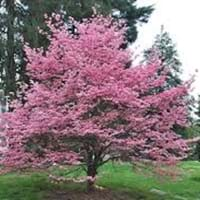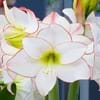Life Span
Perennial
Perennial
Type
Bulb or Corm or Tuber
Tree
Origin
Hybrid origin
Canada, Mid-Atlantic United States, North America, North-Central United States, Southeastern United States
Types
Not Available
Purple Glory dogwood, Cherokee Chief dogwood, Cherokee Daybreak dogwood
Number of Varieties
Not Available
Habitat
tropical environments
foothill woods, gardens, Near ponds, Wet Woods, Woodlands
USDA Hardiness Zone
8-11
5-9
AHS Heat Zone
Not Available
8-1
Sunset Zone
21,22
2a, 2b, 3a, 3b, 4, 5, 6
Habit
Clump-Forming
Pyramidal
Flower Color
White, Red, Light Pink
White, Ivory
Flower Color Modifier
Bicolor
Bicolor
Fruit Color
Green, Brown
Purple, Black
Leaf Color in Spring
Green, Dark Green
Green
Leaf Color in Summer
Light Green
Green
Leaf Color in Fall
Several shades of Green
Burgundy
Leaf Color in Winter
Light Green
Not Available
Leaf Shape
Long Linear
Ovate
Plant Season
Spring, Summer, Winter
Spring, Summer, Fall, Winter
Sunlight
Full Sun, Partial Sun
Bright direct sunlight, Partial Sun
Growth Rate
Medium
Medium
Type of Soil
Loam, Sand
Clay, Loam
The pH of Soil
Acidic, Neutral
Acidic
Soil Drainage
Well drained
Well drained
Bloom Time
Not Available
Late Spring, Early Summer
Tolerances
Deer resistant
Cold climate, Soil Compaction
Where to Plant?
Container, Ground, Pot
Ground
How to Plant?
Divison, From Rhizomes, Tubers
Seedlings, Stem Cutting
Plant Maintenance
Low
Medium
Watering Requirements
Average Water Needs
Allow to dry out slightly between watering, occasional watering once established
In Summer
Lots of watering
Lots of watering
In Spring
Moderate
Moderate
In Winter
Average Water
Average Water
Soil pH
Acidic, Neutral
Acidic, Neutral
Soil Type
Loam, Sand
Loam, Moist, Well drained
Soil Drainage Capacity
Well drained
Well drained
Sun Exposure
Full Sun, Partial Sun
Full Sun, Partial Sun, Partial shade
Pruning
Cut or pinch the stems, Remove damaged leaves, Remove dead branches, Remove dead leaves
Prune if you want to improve plant shape, Prune lower leaves, Prune once the plant is tall enough
Fertilizers
as it is a flowering plant, use high phosphorous content fertilizer, Nitrogen, Phosphorous, Potassium, Requires high amount of nitrogen
Fertilize in early spring, Mulch
Pests and Diseases
Aphids, Grasshoppers, Mealybugs, Mites, Red blotch, Slugs, Snails
Crown rot, Leaf spot, Red blotch, Whiteflies
Plant Tolerance
Deer resistant
Humidity, Light Frost
Flower Petal Number
Not Available
Single
Edible Fruit
Not Available
No
Fragrant Flower
Not Available
Yes
Showy Bark
No
Not Available
Foliage Texture
Medium
Medium
Foliage Sheen
Glossy
Glossy
Attracts
Bees, Butterflies, Hummingbirds
Birds, Butterflies, Hummingbirds, Squirrels
Allergy
poisonous if ingested
allergic conjunctivitis, Headache, Pollen
Aesthetic Uses
Beautification, Bouquets, Cottage Garden, Showy Purposes
Beautification, Cottage Garden, Showy Purposes
Beauty Benefits
Not Available
For treating wrinkles, Makes teeth white, Making cosmetics, Skin cleanser
Environmental Uses
Not Available
Forms dense stands, Nesting sites for birds, Shadow Tree, soil stabilisation
Medicinal Uses
Not Available
Antibiotic, Appetite enhancer, Cough, Diuretic, Emollient, Weight loss
Part of Plant Used
Flowers
Bark, Flowers, Fruits, Leaves
Other Uses
Used as Ornamental plant, Used for bedding in gardens
Application in Handicrafts, Decoration Purposes, Grown for shade, Used as Ornamental plant
Used As Indoor Plant
Yes
No
Used As Outdoor Plant
Yes
Yes
Garden Design
Container, Cutflower, Houseplant, Mixed Border, Tropical
Edging, Feature Plant, Shade Trees
Botanical Name
HIPPEASTRUM 'Picotee'
Cornus florida
Common Name
Florist Amaryllis, Hippeastrum, Picotee Hippeastrum
Flowering dogwood
In Hindi
HIPPEASTRUM
flowering dogwood
In German
HIPPEASTRUM
Wechselblättriger Hartriegel
In French
HIPPEASTRUM
Cornus florida
In Spanish
Hippeastrum
Cornus florida
In Greek
Hippeastrum
Cornus florida
In Portuguese
HIPPEASTRUM
Cornus florida
In Polish
Hippeastrum
Cornus florida
In Latin
Hippeastrum
Cornus florida
Phylum
Magnoliophyta
Magnoliophyta
Class
Magnoliopsida
Magnoliopsida
Order
Asparagales
Cornales
Family
Amaryllidaceae
Cornaceae
Clade
Angiosperms, Monocots
Angiosperms, Asterids, Eudicots
Tribe
Not Available
Not Available
Subfamily
Amaryllidoideae
Not Available
Season and Care of Hippeastrum and Flowering Dogwood
Season and care of Hippeastrum and Flowering Dogwood is important to know. While considering everything about Hippeastrum and Flowering Dogwood Care, growing season is an essential factor. Hippeastrum season is Spring, Summer and Winter and Flowering Dogwood season is Spring, Summer and Winter. The type of soil for Hippeastrum is Loam, Sand and for Flowering Dogwood is Clay, Loam while the PH of soil for Hippeastrum is Acidic, Neutral and for Flowering Dogwood is Acidic.
Hippeastrum and Flowering Dogwood Physical Information
Hippeastrum and Flowering Dogwood physical information is very important for comparison. Hippeastrum height is 38.10 cm and width 30.10 cm whereas Flowering Dogwood height is 550.00 cm and width 490.00 cm. The color specification of Hippeastrum and Flowering Dogwood are as follows:
Hippeastrum flower color: White, Red and Light Pink
Hippeastrum leaf color: Green and Dark Green
Flowering Dogwood flower color: White and Ivory
- Flowering Dogwood leaf color: Green
Care of Hippeastrum and Flowering Dogwood
Care of Hippeastrum and Flowering Dogwood include pruning, fertilizers, watering etc. Hippeastrum pruning is done Cut or pinch the stems, Remove damaged leaves, Remove dead branches and Remove dead leaves and Flowering Dogwood pruning is done Prune if you want to improve plant shape, Prune lower leaves and Prune once the plant is tall enough. In summer Hippeastrum needs Lots of watering and in winter, it needs Average Water. Whereas, in summer Flowering Dogwood needs Lots of watering and in winter, it needs Average Water.





